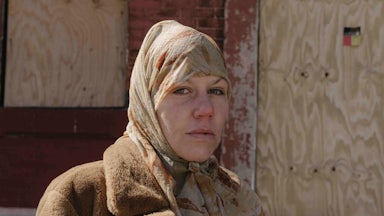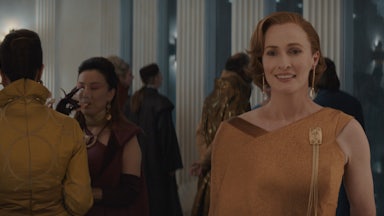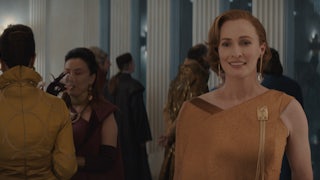It was the summer of 1992, and Sharon Stone was learning to play tennis on the French Riviera. Basic Instinct had opened the Cannes festival that spring, and Stone, who would henceforth be famous forever, had paid off her parents’ mortgage with a check for $17,000. Her mother called to let Stone know that her father had gone to buy sandwiches and let himself contemplate ordering the one that was 25 cents more expensive than usual. “I stood there, tennis racket in hand,” Stone writes, thinking, “Yes, this is what rich people do.”
It’s one of several well-observed scenes of alienation that make Stone’s new book, The Beauty of Living Twice, an unusually readable Hollywood memoir. The two lives of the title are ostensibly the person she was before her devastating stroke in 2001 and the one she’s been since. But they could equally refer to Sharon Stone the person and Sharon Stone the celebrity—a shape-shifting and powerful entity who seems to have lived a completely different life from its author.
It’s the stuff of promotional profiles to observe that there’s more than meets the eye when it comes to a famous person, but Stone is a celebrity so classic that all the clichés seem fascinating in her case. She is a Hollywood archetype, and still commands the type of fame that only attends women who are not so much beautiful as the commercial standard against which all following beautiful famous women are inevitably measured. Sometimes called the “last movie star,” as she notes in the book, Stone honed her personal style in the 1990s into a kind of minimal luxe mixture of expensive Calvin Klein and Gap tees, and it’s profoundly in fashion today.

Her appeal is more than classy separates; the presence of Sharon Stone is the reason Instagram is full of admiring photographs of her red carpet looks. Her cold on-screen affect indicates a person who is in control of all her multiple selves at all times. Stone is a star from the era when erotic psychodramas rained money, a luxuriant and distant dream today, and therefore recalling her peak means recalling a time when a woman could build her public persona on fictional villainy rather than the relentless nonfiction drip of social media updates.
Nostalgic though her life story may be for us, Stone lived it. Insightful first-person writing about the experience of being commodified is rare; there aren’t exactly a lot of her peers around, let alone ones who can write. But Stone does seem to have written the book herself. In an interview with The New York Times, Stone recently recalled that Sonny Mehta, the late and legendary Knopf publisher, and the editor Tim O’Connell let her spend a snowy winter writing in Mehta’s office. “I’d slog down there in my hat and my down coat with my computer and my stuff,” she said, and knock out memories.
She’s a good storyteller. What she remembered in the Knopf offices alternates between multiple plotlines, including her “kitchen-sink Irish” origins in rural Pennsylvania and her bumpy and belated journey to fame. She roller-skated to her audition to be an extra in a Woody Allen movie, Stardust Memories, because she was trying to shed the “country” weight she was told made her less castable. She didn’t get any lines but produced a luminous scene where she blows a kiss at Allen through a window—a moment of pure, blazing charisma, now told from the perspective of the fire.
Events like Basic Instinct feel fated. In the role of Catherine Tramell, and in almost every subsequent movie Stone helped make a hit, she plays a mysterious and sexy woman whose motives are difficult to ascertain. She was very good at it. In Basic Instinct, Total Recall, and Diabolique, she’s an emotional double agent, a woman whose (occasionally queer) erotic games confound men who are disoriented by her manipulation. In Casino she exploits the hero for money, while refusing to love him. As with Glenn Close in Fatal Attraction, the secret of her true feelings makes Sharon Stone a walking dose of plot suspense. She even played a Clint Eastwood–alike gunslinger in The Quick and the Dead, her self-produced 1995 Western, blue eyes narrowing under her hat as we wait for the quick-draw and the bang.
In all these roles, Stone offers us the fantasy of total control and domination. Hers is a hotness that humiliates a person for desiring it: Like Michelle Pfeiffer coldly surveying the landscape of Scarface before her, Stone’s celebrity was built on the power of her blonde disdain, and the things it can do to a plot.
The gossipy moments in this book are juicy, like the time nobody at Cannes would lend her a dress, even though she’d lost her luggage. Her occasional lapses into divahood, meanwhile—Stone indignantly recalls accidentally offending the entire nation of China after an earthquake by suggesting that it might be “karma” for the way they’d treated Tibetans—are frankly more entertaining to read than the more virtuous edit of the same event would have been. There’s a touch of Eve Babitz to her style.
But The Beauty of Living Twice is also about looking back on one’s own exploitation. A woman’s performance of power in public—the all-knowing sexual omnipotence built into the idea of Sharon Stone’s celebrity, you could say—has had little to no correlation, in her experience, with her day-to-day life. She depicts childhood abuse with exquisite control. “We were there in the room with the light coming in from the windows in the way that holds the dust in the air so that you can see it floating in slow motion and you just can’t breathe,” she writes.
As an adult, Stone saw the famous crotch-shot in Basic Instinct for the first time in “a room full of agents and lawyers, most of whom had nothing to do with the project.” All she had been told was, “We can’t see anything—I just need you to remove your panties, as the white is reflecting the light, so we know you have panties on.” It’s a powerfully ironic memory, since in the movie Stone flashes the cops in an act of aggression, tempting them to lose their focus. In reality, an inverse dynamic of distraction and gendered manipulation took place.
Stone’s experience teaches that the appearance of feminine power in the media can be used as a weapon to deprive real-life women of actual power. Catherine Tramell is such an iconic performance that even noting the manipulation behind her production seems to undermine Stone’s achievement, as if the whole conceit of her talent only works if she was really in charge the whole time. In 2018, an interviewer asked Sharon Stone if she had any #MeToo stories, and she laughed long and bitterly.
The drawbacks of being a Hollywood symbol crop up again in the story of her neurological injury, and again they concern the issue of credibility. When Stone first went to hospital, she recalls, staff didn’t take her symptoms seriously: “Being an actress and all—hey, I know; it comes with the territory.” They essentially sent her home, when in truth she was days into a stroke. It became an ordeal of brain bleeding and Dilaudid, during which she had visions of “falling through what looked like piles of colored fabric” and heard the voice of veteran Hollywood publicist Pat Kingsley saying kind things to her.
“Oh, yeah, I got it but good,” she writes. “I got the big spanking.” She eventually left the hospital “without a vertebral artery and with twenty-three platinum coils in its place,” alive but with impaired hearing and a host of other physical and mental symptoms. Her narrow survival and long recovery from this event overlie Stone’s recollections of abuse in a way that makes the contradiction of suffering in private while symbolizing power in public seem particularly painful.
The Beauty of Living Twice is a book about Sharon Stone’s life, which makes it a book about how women take on multiple personas when they become very famous, then struggle to keep them in order. When your image has a monetary value, she gradually argues, it will at times have interests that are at curiously precise odds with your own. As in the moment of transformation on the Riviera tennis court, Stone is a strong portraitist of the instant in time, and aware that stardom, like identity, is mostly a phenomenon of the memory—the true movie star is the one you remember compulsively, long after seeing her on screen. That person is now a memory to herself. “I don’t miss her,” Stone writes. “It’s like she is a person I knew very intimately, but not me.”








